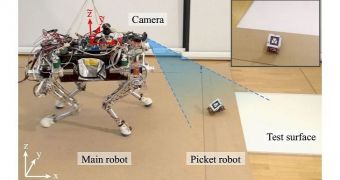Robots were pegged as the ideal scouts ages ago, but they've only recently begun to be used in military operations, or at least test runs. The ground-based variety anyhow. Now, a certain team of researchers claim to have solved one of the main problems with big robot exploration: forewarning.
You see, it's true that the whole point of using robots as scouts is to give the human soldiers forewarning in regard to what may expect them in or beyond a certain area.
However, robots have their own problems in the way that the terrain is seldom friendly enough to let them get through a scouting mission without stumbling or damaging something.
You see, robots, legged ones especially, are far from possessing the kind of balance and grace that you're used to seeing in Sci Fi flicks. Maybe in a decade or so, that will have changed, but for now, no dice.
And depending on where the survey cameras and sensors are mounted, a multi-legged robot like the StarlETH quadruped from ETH Zurich could slip on a patch of ice and take a spectacular tumble without catching any hint of why it had happened.
Robots like that one cost thousands of dollars to make, so it's understandable that scientists and the military high brass would be leery of just sending the things in and hope for the best.
Researchers from the Biomimetic Millisystems Lab at the University of California, Berkeley, claim to have developed a solution: throw some smaller bots to the wolves first.
In their study called "Detection of Slippery Terrain with a Heterogeneous Team of Legged Robots," they propose that smaller bots be used as scouts, to check whether there are any hazards in the path of the robot you mean to send off.
They demonstrated their concept by means of a small piece of machinery called VelociRoACH, which moved ahead of the big StarlETH robot. The latter and the former apparently had a sort of collaboration established between them, instead of depending exclusively on one or two people to guide them wirelessly from wherever.
That the small robot possessed the internal state estimation capability, and remote sensing ability for that matter, as the main robot was a very good thing. Essentially, the two robots operated by joining their perception.
Synchronization at its finest you could call it, so we suppose a case could be made that the small robot wasn't really thrown to the wolves (potential enemies) for the sake of the bigger one, because the bots were never far from each other.

 14 DAY TRIAL //
14 DAY TRIAL //